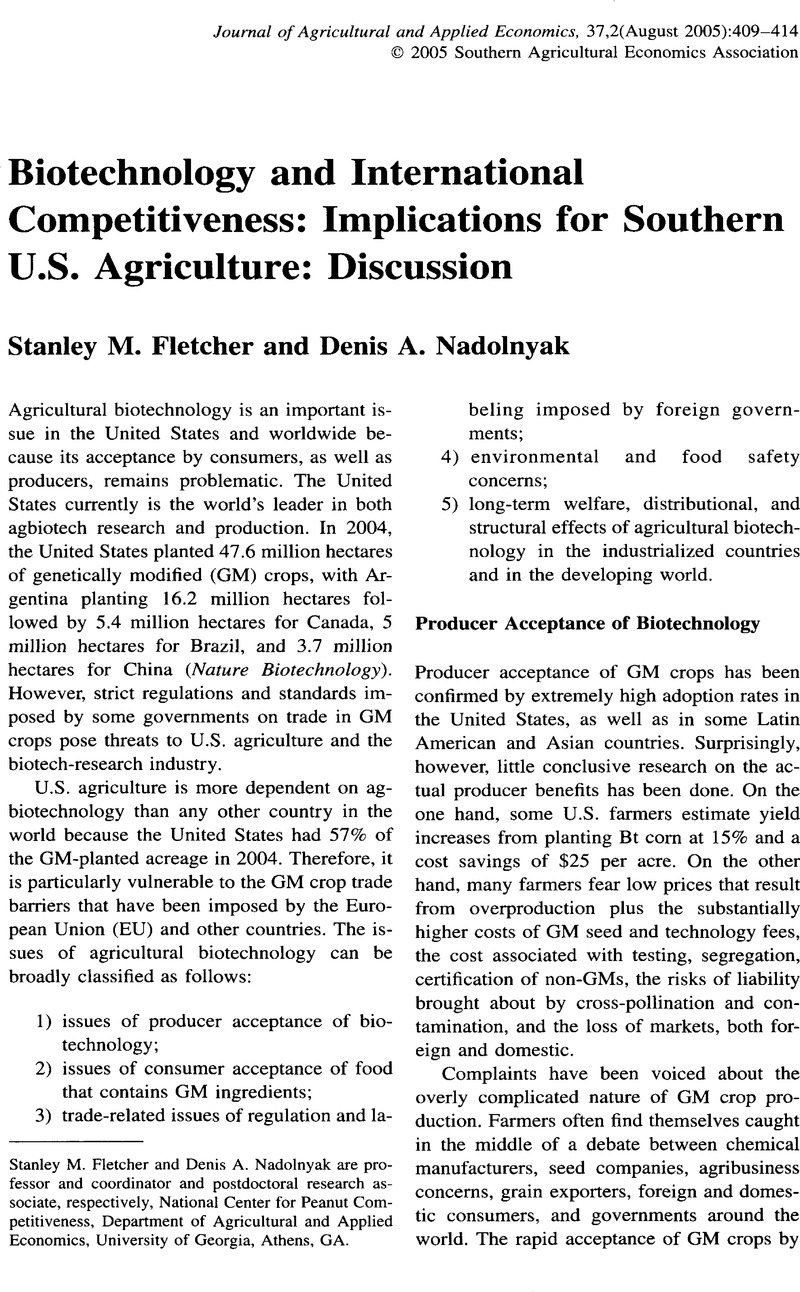No CrossRef data available.
Article contents
Biotechnology and International Competitiveness: Implications for Southern U.S. Agriculture: Discussion
Published online by Cambridge University Press: 28 April 2015
Abstract
An abstract is not available for this content so a preview has been provided. Please use the Get access link above for information on how to access this content.

- Type
- Invited Paper Sessions
- Information
- Copyright
- Copyright © Southern Agricultural Economics Association 2005
References
CropBiotech Net. Various issues. Knowledge. center@isaaa.org. Internet site: www.isaaa.org/kc (Accessed March 31, 2005).Google Scholar
Fernandez-Cornejo, G., and McBride, W.D.. Adoption of Bioengineered Crops. ERS Agricultural Economic Report No. AER810, 2001. Internet site: ers.usda.gov/publications/aer810/ (Accessed March 15, 2005).Google Scholar
Harhoff, D., Regibeau, P., and Rockett, K.. “Some Simple Economics of GM Food.” Economic Policy 16,33(2001):265–299.CrossRefGoogle Scholar
International Food Policy Research Institute (IFPRI). Global Study Reveals New Warning Signals: Degraded Agricultural Lands Threaten World's Food Production Capacity. May 2000. Internet site: http://www.ifpri.org/ (Accessed February 23, 2005).Google Scholar
Jolly, C, Jefferson, K., and Traxler, G.. Consequences of Biotechnology Policy for Competitiveness and Trade of Southern U.S. Agriculture. Journal of Agricultural and Applied Economics 37,2(2005):000–000.Google Scholar
Nature Biotechnology. 23,3(2005):281. Internet site: http://guide.nature.com/ (Accessed March 27, 2005).CrossRefGoogle Scholar
Marchant, Mary A., and Song, B.. “Assessment of Biotechnology Policies and International Trade in Key Markets for U.S. Agriculture.” Journal of Agricultural and Applied Economics 37,2(2005):000–000.CrossRefGoogle Scholar
Shoemaker, R., Harwood, J., Day-Rubenstein, K., Dunahay, T., Heisey, P., Hoffman, L., Klotz-Ingram, C., Lin, W., Mitchell, L., McBride, W., and Fernandez-Cornejo, J.. Economic Issues in Agricultural Biotechnology. ERS Agriculture Information Bulletin No. 762, 2001. Internet site: http://www.ers.usda.gov/publications/aib762/ (Accessed March 10, 2005).Google Scholar
Traxler, G.J. “Assessing the Prospects for the Transfer of Genetically Modified Crop Varieties to Developing Countries.” Agbioforum 2,3-4(1999). Internet Site: http://www.agbioforum. org. (Accessed March 26, 2005).Google Scholar
U.S. Department of Agriculture, Economic Research Service. Briefing room: Agricultural Biotechnology: Recent Research Developments. Internet site: http://www.ers.usda.gov/Briefing/Biotechnology/researchdevelopments.htm (Accessed March 20, 2005).Google Scholar
Wailes, E.J. “Concepts, Issues, and Analysis of Biotechnology on International Competitiveness.” Invited paper presented at the Southern Agricultural Economics Association's Annual Meeting, Little Rock, AR, February 2005.Google Scholar




